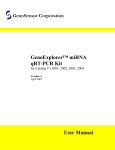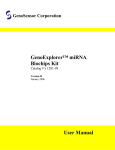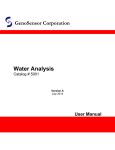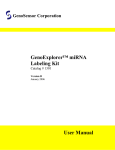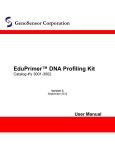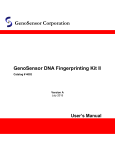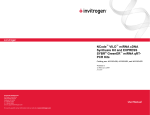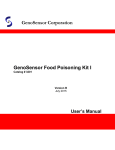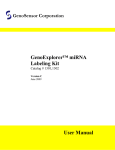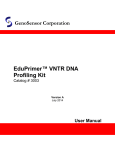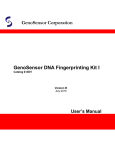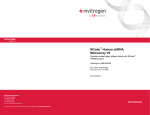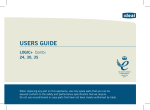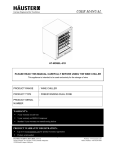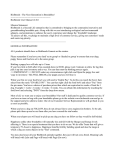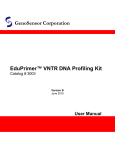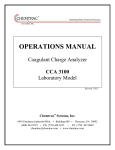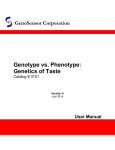Download GenoExplorer™ miRNA qRT-PCR Kit User Manual
Transcript
GenoSensor Corporation GenoExplorer™ miRNA qRT-PCR Kit for Catalog #’s 2001, 2002, 2003, 2004, 2005 Version B User Manual GenoExplorer microRNA qRT-PCR Kit Table of Contents Introduction ……………………………………………………………………………… 2 Product System ………………………………………………………………………...... 2 Kit Components and Storage Condition …………………………………………………... 5 Additional Required Materials ……………………………………………………………. 6 Related Products from GenoSensor ……………………………………………………….. 6 GenoExplorer™ miRNA qRT-PCR Quick Start Protocol .................................................. 7 GenoExplorer™ miRNA qRT-PCR Detailed Protocol ...................................................... 8 Appendix ............................................................................................................................ 12 Troubleshooting ................................................................................................................... 12 Technical Service .................................................................................................................. 13 Literature Citation When describing a procedure for publication using these products, we would appreciate that you refer to them as the GenoExplorer™ miRNA qRT-PCR Kit. Patents and Trademarks GenoExplorer is a trademark of GenoSensor. The GenoExplorer™ miRNA qRT-PCR Kit and the GenoExplorer™ miRNA Primer Sets are covered by patents pending. 1 GenoExplorer microRNA qRT-PCR Kit Introduction Overview The GenoExplorer™ miRNA qRT-PCR System is a highly robust and efficient system for amplifying specific microRNA molecules or other small non-coding RNA from small quantities of total RNA to generate sufficient amounts of material for downstream study. This system is engineered for use with as little as 10 ng of isolated total RNA as starting material. The procedure is simple and requires no purification and allows for detection of either mature or precursors microRNAs in the sample in less than three hours. MicroRNAs are a class of non-coding single stranded RNA molecules that regulate their targets by translational inhibition and mRNA destabilization. Increasing evidence suggests that microRNAs may also play a major role in cellular transformation and carcinogenesis by acting either as oncogenes or tumor suppressors. They are transcribed as primary miRNAs which are then processed to a shorter, hairpin pre-miRNAs approximately 70-90 nucleotides structures by a nuclear enzyme Drosha, then further processed by a cytoplasmic enzyme Dicer RNAse III-like endonuclease to approximately 20-22 nucleotides single stranded Mature miRNAs. Despite hundreds of miRNAs that have been discovered, the actual mechanism by which they regulate cellular functions, such as regulation of developmental timing, pattern formation, and secretion, are not well understood. Several aspects of miRNAs made them elusive and difficult to detect and study, such as their small size, lack of poly-adenylated tails, their propensity to bind targets with imperfect sequence homology, and also their sequence homology within families, the detection technology must be able to distinguish sequences that differ only by 1–2 nucleotides Product System Workflow The GenoExplorer™ miRNA qRT-PCR kit contains the first-strand cDNA synthesis and SYBR® Green I qPCR reagent mix. Following isolation of total RNA, all the miRNAs in the sample are modified by linking an adaptor at the 5’ end using ligase and polyadenlyated using poly A polymerase. The universal RT Primer is then used to synthesize cDNA from the tailed miRNA population by reverse transcriptase. The first-strand cDNA is ready for analysis in qPCR using SYBR Green detection reagents. A specific miRNA primer and the universal primer are used for PCR reactions (Fig 1). The designed primer sets are optimized to amplify the specific miRNA for either mature or precursor forms. Specific primers for any miRNAs in all species can be chosen and ordered from the GenoExplorer™ miRNA qRT-PCR Primer Sets. 2 GenoExplorer microRNA qRT-PCR Kit 5’ 5P Mature Precursor 3’ 3P Mature Expand both ends by ligation and extension Reverse transcribe to cDNA PCR primer design Fig 1. GenoExplorerTM microRNA qRT-PCR principle and primer design. Advantages of the Kit Accurate and Specific Quantification The GenoExplorer™ miRNA qRT-PCR Kit (patented) provides a simple and highly specific method for miRNA quantification. Mature miRNAs situate at either 5’ or 3’ end or both ends of precursor miRNAs. Both ends of miRNA molecules are elongated in this method by 5’ ligation and 3’ poly(A) extension. This modification allows primer design for specific miRNA isoforms. The method generates a miRNA cDNA library. The library will be further analyzed for specific mature or precursor miRNAs using PCR. Simplified Protocol The system does not need additional chloroform or column purification. The simple protocol makes the quantitation achievable within one day. All required reagents are included. Specific PCR primers, however, need to be purchased separately based on 3 GenoExplorer microRNA qRT-PCR Kit specific miRNA targets (refer GenoExplorer™ miRNA qPCR primer sets Cat # 2003) as well as internal reference controls (Cat # 2004). Flexibility for Real-Time or End-Point Measurement The assay offers flexibility to do real-time or end-point PCR measurement by a variety of instrument. Product Specification The kit provides enough reagents for 10 cDNA synthesis using total or enriched RNA and 100 PCR reactions. cDNA is used for any specific PCR primer pairs. Specific primers are available with separate orders (Cat # 2003 and 2004). 4 GenoExplorer microRNA qRT-PCR Kit Kit Components and Storage Conditions • GenoExplorer™ miRNA qRT-PCR Kit (Cat# 2001) Components Poly(A) extension mix RT priming mix Annealing buffer 2X RT mix 2X GenoExplorer SYBR Green qPCR mix Amount 30 µl 80 µl 60 µl 100 µl 750 µl Storage -20º C -20º C -20º C -20º C -20º C • GenoExplorer™ miRNA First-Strand cDNA Core Kit (Cat# 2002) has everything in Cat# 2001 but not 2X SYBR Green qPCR mix • GenoExplorer™ miRNA qPCR Primer Sets (Cat# 2003) Components Amount Forward primer (specific miRNA primer) 100 µl Universal reverse primer 100 µl Storage -20º C -20º C • GenoExplorer™ miRNA qPCR Reference Primer Sets (Cat# 2004) Components Amount Storage -20º C Forward primer (specific reference primer) 100 µl -20º C Universal reverse primer 100 µl • GenoExplorer™ 2X qPCR Mix (Cat# 2005) Components 2X SYBR qPCR mix Amount 750 µl Storage -20º C Shipping and Storage GenoExplorerTM miRNA qRT-PCR kits are shipped on dry ice. Components should be stored at temperatures shown in the above table. At proper storage conditions, components are stable for 1 year from the date received. Expiration dates are also noted on product labels. Safety Warnings and Precautions For research use only. Not recommended or intended for the diagnosis of disease in humans or animals. Do not use internally or externally in humans or animals. Consider all chemicals as potentially hazardous. Only persons trained in laboratory techniques and familiar with the principles of good laboratory practice should handle these products. Wear suitable protective clothing such as laboratory overalls, safety glasses, and gloves. Exercise caution to avoid contact with skin or eyes: if contact should occur, wash immediately with water (Material Safety Data Sheet for products is available upon request). 5 GenoExplorer microRNA qRT-PCR Kit Additional Required Materials Total RNA containing the small RNA RNase-free water Adjustable pipettors RNase-free tips RNase-free polypropylene microcentrifuge tubes (0.2, 0.5 or 1.5 ml) Graduated cylinder Microcentrifuge Incubator set at 37º C Incubator set at 42º C Incubator or heating block set at 75º C Heating block at 95º C Thermocyclers (real-time feature is optional) Minicentrifuge Electrophoresis system (optional) The GenoExplorer™ qRT-PCR kit is open to a variety of equipment. The examples given are only suggestions rather than specific recommendations. Please contact technical support if you have specific questions. Related Products from GenoSensor GenoExplorer™ microRNA Array Full Kit (Cat# 1101 – 1199) GenoExplorer™ microRNA Array Labeling Kit (Cat# 1301) GenoExplorer™ microRNA Biochips Kit (Cat# 1201 – 1299) GenoExplorer™ microRNA Probe Set (Cat# 1401 –1499) GenoExplorer™ Reagents for Hybridization Assay (Cat# 1501 –1504) GenoExplorer™ microRNA qRT-PCR Kit (Cat# 2001) GenoExplorer™ microRNA First-Strand cDNA Core Kit (Cat# 2002) GenoExplorer™ microRNA qPCR Primer Sets (Cat# 2003) GenoExplorer™ microRNA qPCR Reference Primer Sets (Cat# 2004) GenoExplorer™ 2X qPCR Mix (Cat# 2004) 6 GenoExplorer microRNA qRT-PCR Kit Quick Start Protocol Part I. Extension Procedure Add the following reagent in a 0.2 ml DNase/RNase-free tube on ice • Total RNA (10ng – 1µg) ………………… X µl • Poly(A) extension mix ……………. 3 µl • DNase/RNase-free water (to 10 µl total) …. X µl (total 10 µl) Mix well and incubate at 37 ºC for 30 minutes Heat at 95 ºC for 5 min and cool on ice Part II. First-Strand cDNA Synthesis Procedure Add the following reagent in a 0.2 ml DNase/RNase-free tube on ice • Extended RNA (from previous step Part I) … 2 µl • RT priming mix ……………………. 8 µl (total 10 µl) Incubate at 46 ºC for 10 min Chill on ice and add the following • 2X first-strand mix ……………………. 10 µl (total 20 µl) Incubate at 42 ºC for 60 min Heat at 95 ºC for 5 min Chill on ice or store at –20 °C Part III. qPCR Procedure Directly use previous cDNA or dilute it 1:10 (see detailed protocol) • cDNA template (from previous step Part II)… 2 µl • 2X GenoExplorer SYBR qPCR mix …….. 7.5 µl • Forward primer …………………………….. 1 µl • Reverse Primer …………………………….. 1 µl • DNase/RNase-free water …………… 3.5 µl (total 15 µl) Perform PCR using either real-time or end-point measurement Standard Cycling Program Denature: 94 ºC for 15 minutes 30 – 50 cycles of: Denature: 94 ºC, 30 seconds Anneal: 59 ºC, 15 seconds Elongate: 72 ºC, 30 seconds Elongate: 72 ºC, 1 minute (for end-point qPCR measurement only) Store: 4 ºC Note: Annealing temperature may be variable 7 GenoExplorer microRNA qRT-PCR Kit GenoExplorer™ miRNA qRT-PCR Detailed Protocol General Description GenoExplorer™ miRNA qRT-PCR system employs elongation of both ends of miRNAs by a 5’end ligation and 3’ poly(A) extension approach, followed by reverse transcription. This offers greater selectivity for PCR primer design and specificity to quantify either mature or precursor miRNA forms. The amplified PCR is specific for individual forms without mixture of both. The modified miRNAs are then reverse transcribed to cDNA. Specific miRNAs are amplified and quantified by PCR. Handling RNA Samples When working with RNA, always use proper microbiological aseptic techniques. Use RNase- and DNase-free reagents, water, glassware and plasticware. Use non-powdered gloves during all steps of sample labeling, chip hybridization, washing, detection, and scanning. RNA Preparation Total RNA or enriched small RNA samples are recommended. In this protocol, starting from total RNA (10ng – 1µg) was described. High quality and sufficient amounts of RNA samples is crucial for experiments with microarrays. RNA quality can be evaluated by visualizing the RNA on a gel, as well as by calculating the A260/A280 ratio. On a denaturing gel (or on an ordinary agarose gel in denaturing buffer) the RNA should appear as two bright distinct bands that represent the 28S and 18S ribosomal species. The 28S band should be brighter than the 18S band. Tailing of these major bands down the gel, or a background smear behind these bands that gets heavier at lower molecular weights can indicate degradation of the RNA. Degraded RNA will produce high background and low signal intensity microarray results. 8 GenoExplorer microRNA qRT-PCR Kit PART I. Extension of miRNA In this step, the miRNA is extended. Required Materials The following materials are supplied in the GenoExplorerTM miRNAqRT-PCR kit • Poly(A) extension mix The following materials are supplied by the user • 10ng to 1µg of total RNA • Microcentrifuge • Heat block or water bath set at 37 °C • RNase-free pipette tips • 0.2 and 1.5-ml DNase/RNase-free microcentrifuge tubes • DNase/RNase-free water Extension Procedure At room temperature, add the poly(A) extension reagents in a 0.2 ml reaction tube 1. Component Amount • Total RNA (10ng – 1µg) ……………………. X µl • Poly(A) extension mix ……………………. 3 µl • DNase/RNase-free water (to 10 µl total) ……… X µl (total 10 µl) 2. Mix gently (do not vortex) and centrifuge the tube briefly to collect the contents. 3. Incubate the tube in a heat block or water bath at 37 °C for 30 minutes. 4. Heat at 95 °C for 5minutes, cool the reaction on ice and proceed immediately to First Strand cDNA Synthesis. Note: Each extended reaction provides enough for five cDNA synthesis reactions. PART II. First Strand cDNA synthesis This step is to synthesize the first strand cDNA from the extended miRNAs Required Materials The following materials are supplied in the kit • RT priming mix • Annealing buffer • 2X RT mix The following materials are provided by the user • Thermal cycler or incubator • Microcentrifuge • Ice • 0.2 and 1.5-ml RNase-free microcentrifuge tubes • RNase-free pipette tips 9 GenoExplorer microRNA qRT-PCR Kit First-Strand cDNA Synthesis Procedure 1. Centrifuge the 10 µl of extended RNA from previous step and place on ice. Use 2 µl of the 10 µl for the following step. 2. Component Amount • Extended RNA (from previous step Part I) ……. 2 µl • RT priming mix …………………………… 8 µl 3. Incubate the tube at 46 ºC for 10 minutes. 4. Place the tube on ice for 1 minute. Note: • In most cases, Annealing Buffer is not required. If non-specific PCR products are seen, adding the Annealing Buffer and reducing the RT priming mix to keep final volume of 10 µl are recommended. • This procedure is for a single reaction. However, for multiple reactions, prepare a master mix with a 5% overage for accurate pipetting. 5. Add the following to the tube, to a final volume of 20 µl • 2X RT mix …………………………………… 10 µl 6. Briefly spin the tube briefly to collect the contents. 7. Transfer the tube to a thermal cycler preheated to 42 ºC and incubate for 60 minutes. 8. Incubate at 95 ºC for 5 minutes to stop the reaction then chill the reaction on ice. 9. Store aliquots at –20 ºC or proceed immediately to qPCR. Note: For starting material of 100ng or less of total RNA, use 2 µl of cDNA from previous step for qPCR reaction. For amounts of 1µg or more of total RNA, make 1:10 dilution of cDNA by adding DNase/RNase-free water to 200 µl (final volumes) and use 2µl of the diluted cDNA for qPCR reaction. For amount of 100ng - 1µg total RNA, dilution should be based on the abundance of your target RNA in the sample. PART III. qPCR This step is to quantitatively amplify specific miRNA transcripts from the first strand cDNA. The PCR can be performed by either real time or end point. Required Materials The following materials are supplied in the kit • 2X GenoExplorer SYBR qPCR mix The following materials are needed to prepare or purchase separately • Specific PCR primers (purchase GenoExplorerTM miRNA qPCR Primer Sets Cat # 2003). • Reference control primers (purchase GenoExplorerTM miRNA qPCR Reference Primer Sets Cat # 2004). The following materials are provided by the user 10 GenoExplorer microRNA qRT-PCR Kit • • • • • • Thermal cycler Microcentrifuge Ice 0.2 and 1.5-ml RNase-free microcentrifuge tubes RNase-free pipette tips DNase/RNase-free water PCR Procedure 1. Add the following components to each DNase/RNase-free PCR tube or plate well Component Amount • cDNA template (from step Part II, or diluted) …………… 2 µl • 2X GenoExplorer SYBR qPCR mix ……………………. 7.5 µl • Forward primer (3 µM) …………………………… 1 µl • Reverse Primer (3 µM) …………………………… 1 µl • DNase/RNase-free water …………………………… 3.5 µl (total 15 µl) 2. Cap or seal the tube/plate, and gently mix. Make sure that all components are at the bottom of the tube/plate. Centrifuge briefly if needed. 3. Place reactions in a preheated real-time instrument Suggested Cycling Instrument. The real-time qPCR instrument conditions shown below were executed on an Applied Biosystems ABI 7900 384-well plate system, but also apply to an ABI 7500 or an ABI 7300 real-time PCR system. Other real-time instrument may also be applicable. Real-time qPCR Program Parameters Standard Cycling Program Denature: 94 ºC for 15 minutes 30 – 50 cycles of: Denature: 94 ºC, 30 seconds Anneal: 59 ºC, 15 seconds Elongate: 72 ºC, 30 seconds Elongate: 72 ºC, 1 minutes (for end-point qPCR measurement only) Store: 4 ºC Note: annealing temperature may be variable Run the program. After cycling, hold the reaction at 4 ºC until further analysis. Note on Annealing Temperature This suggested cycling program recommends an annealing temperature of 59ºC. Increasing the annealing temperature may result in better discrimination of closely related miRNA sequences, but with a slight loss in sensitivity. 11 GenoExplorer microRNA qRT-PCR Kit Appendix Troubleshooting Guide No amplification product Missing reaction component Repeat reaction setup. Questionable template quality Analyze starting materials Inhibitory substance in reaction Decrease sample volume. Purify DNA either by alcohol precipitation or dialysis. Insufficient number of cycles Run additional cycles Incorrect thermocycler programming Verify times and temperatures Errors in block temperature Calibrate heating block Contaminated tubes or solutions Autoclave tubes and use filtered pipette tips Primer Annealing temperature too High Non-specific Products Lower annealing temperature in 2° C increments Premature Taq-DNA polymerase replication Add components on-ice (chilled), place PCR-reaction mixtures to preheated (94 °C) thermocycler Primer Annealing temperature too low Raise annealing temperature in 2° increments Insufficient mixing of reaction buffer Excess PCR primers Excess RT-Primer (RT-Priming Mix) Exogenous DNA contamination Reaction buffer must be thoroughly mixed prior to use Reduce Forward and Reverse primer concentration to 0.1-0.4 µM Reduce RT-Priming mix to 8-4µl and bring the volume to 8µl with Water • • • Use non-aerosol tips Set dedicated area for reaction setup Wear gloves. 12 GenoExplorer microRNA qRT-PCR Kit Technical Service For more information or technical assistance, please call, write, fax, or email. GenoSensor Corporation 4665 S. Ash Avenue Suite G-18 Tempe, Arizona 85282 Tel: 1-480-598-5378 Fax: 1-480-755-3319 Email: [email protected] Web: www.genosensorcorp.com Limited Warranty GenoSensor is committed to providing our customers with high-quality goods and services. Our goal is to ensure that every customer is 100% satisfied with our products and our service. If you should have any questions or concerns about a GenoSensor product or service, please contact our Technical Service at [email protected]. GenoSensor warrants that all of its products will perform according to the specifications stated on the certificate of analysis. This warranty limits GenoSensor Corporation’s liability only to the cost of the product. No warranty is granted for products beyond their listed expiration date. No warranty is applicable unless all product components are stored in accordance with instructions. GenoSensor reserves the right to select the method(s) used to analyze a product unless GenoSensor agrees to a specified method in writing prior to acceptance of the order. GenoSensor makes every effort to ensure the accuracy of its publications, but realizes that the occasional typographical or other error is inevitable. Therefore GenoSensor makes no warranty of any kind regarding the contents of any publications or documentation. If you discover an error in any of our publications, please report it to our Technical Service. GenoSensor assumes no responsibility or liability for any special, incidental, indirect or consequential loss or damage whatsoever. The above limited warranty is sole and exclusive. No other warranty is made, whether expressed or implied, including any warranty of merchantability or fitness for a particular purpose. 13














